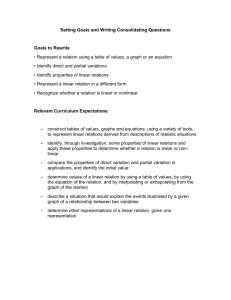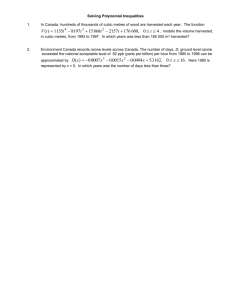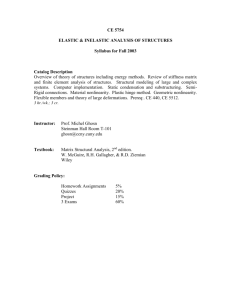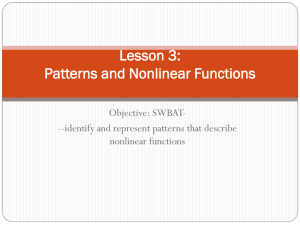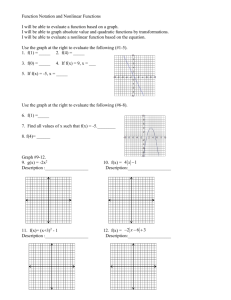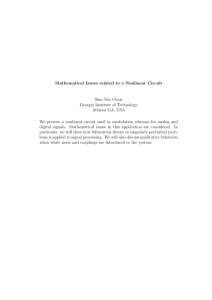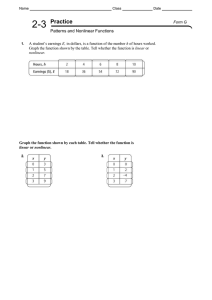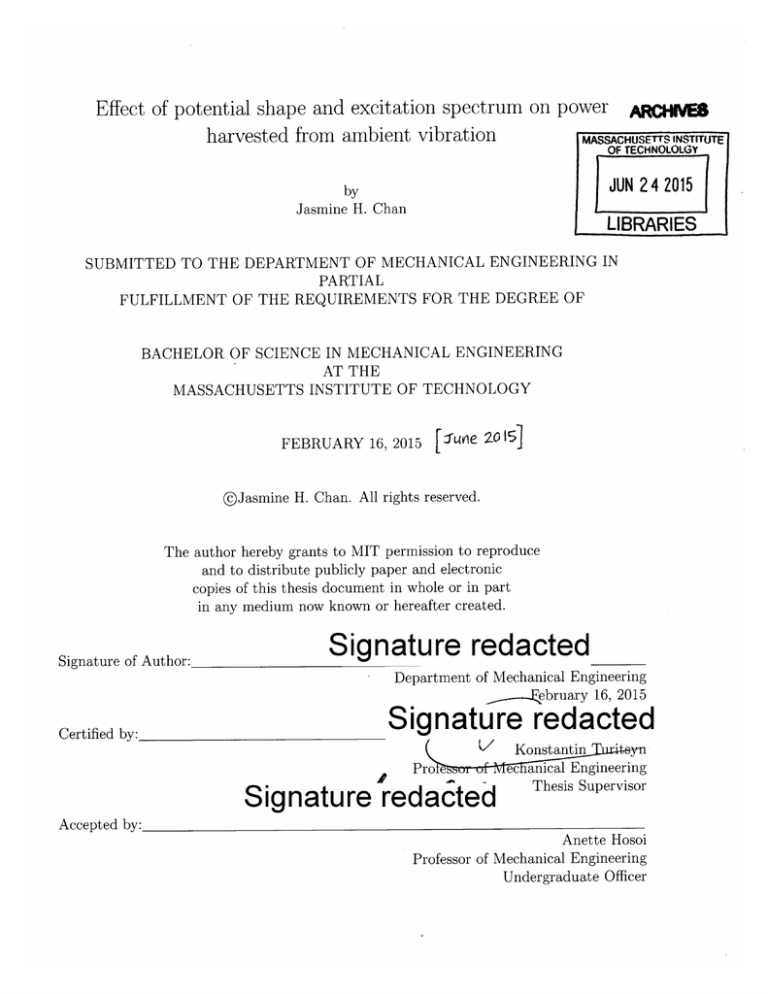
Effect of potential shape and excitation spectrum on power
harvested from ambient vibration
ACH .SN E
MSSACHUSETTERINSTRTUTE
OF TECHNOLOLGY
JUN 2 4 2015
by
Jasmine H. Chan
LIBRARIES
SUBMITTED TO THE DEPARTMENT OF MECHANICAL ENGINEERING IN
PARTIAL
FULFILLMENT OF THE REQUIREMENTS FOR THE DEGREE OF
BACHELOR OF SCIENCE IN MECHANICAL ENGINEERING
AT THE
MASSACHUSETTS INSTITUTE OF TECHNOLOGY
ie 20 15J
FEBRUARY 16, 2015
@Jasmine H. Chan. All rights reserved.
The author hereby grants to MIT permission to reproduce
and to distribute publicly paper and electronic
copies of this thesis document in whole or in part
in any medium now known or hereafter created.
Signature of Author:
Signature redacted
artment of Mechanical Engineering
ebruary 16, 2015
_
gnature redacted
Certified by:
V"
ro e
Signature
lacted
Konstantin
ec anical Engineering
Thesis Supervisor
Accepted by:
Anette Hosoi
Engineering
of
Mechanical
Professor
Undergraduate Officer
Effect of potential shape and excitation spectrum on power
harvested from ambient vibration
by
Jasmine H. Chan
Submitted to the Department of Mechanical Engineering
on February 16, 2015 in Partial Fulfillment of the
Requirements for the Degree of Bachelor of Science in
Mechanical Engineering
ABSTRACT
In recent years, there have been experimental developments in energy harvesting from
ambient vibrations in small-scale sensing. The ultimate goal is to replace batteries in these
sensors. Linear systems have a narrow bandwidth, but ambient vibrations occur over a
potentially broad range of frequencies. Nonlinear systems-in particular, bistable systems
have a wide bandwidth. The objective of this thesis is to understand the dependence of
power harvested on the shape of the potential-in the transition from linear to bistable. A
single degree-of-freedom mathematical model was developed and simulated in MATLAB
over varying operating conditions and potential function parameters. The findings from this
thesis support experimental results that nonlinearity improves the amount of power that is
harvested.
Thesis Supervisor: Konstantin Turitsyn
Title: Professor of Mechanical Engineering
2
Acknowledgements
I would like to thank my Thesis Supervisor, Professor Konstantin Turitsyn from the Department of Mechanical Engineering at the Massachusetts Institute of Technology. His guidance
over the past one and a half years, and in particular the last six months, has been among
the most influential experiences I have had during my undergraduate years. I would also
like to thank Ashkan Haji Hosseinloo, one of Professor Turitsyn's graduate students, for his
assistance, guidance, and availability during the last couple weeks.
3
Contents
1
Introduction
6
2
Mathematical model
2.1 Linear harvester ......................
2.2 Linear-bistable transition and bistable harvester
8
9
9
.
.
. . . . . . . . .
. . . . . . . . .
two frequencies
. . . . . . . . .
.
. . .
. . .
with
. . .
.
3 Simulation and analysis
3.1 Linear responses . . . . .
3.2 Case 1: Harmonic forcing
3.3 Case 2: Harmonic forcing
3.4 Case 3: White noise . .
.
.
.
.
.
.
.
.
.
.
.
.
.
.
.
.
.
.
.
.
.
.
.
.
.
.
.
.
.
.
.
.
.
.
.
.
.
.
.
.
.
.
.
.
.
.
.
.
10
10
12
13
15
4 Conclusions
17
5 Appendix: MATLAB Code
18
References
24
4
List of Figures
1
2
3
4
5
6
7
8
9
10
11
12
Three common designs for creating a bistable system: a) repulsive magnets
at the tip of the cantilever and fixed to the housing; b) attractive magnets at
the tip of the cantilever and fixed to the housing; and c) a buckled beam [1].
Depicted are the three modes of oscillation: a) intrawell oscillations; b) chaotic
oscillations, and; c) interwell oscillations [1]. . . . . . . . . . . . . . . . . . .
A linear and bistable system modeled as a particle on a moving cart: a)
monostable potential; and, b) bistable potential [2]. . . . . . . . . . . . . . .
Sample potential functions as N 1 , N 3 , and r vary. For the monostable potential, r = 0 and N3 = 0. For both the transition and the bistable potentials,
r = 1 and N1 , N3 > 0. N and N 3 in the bistable case are greater than in the
transition case. . . . . . . . . . . . . . . . . . . . . . . . . . . . . . . . . . .
The five graphs above show the potential function of the extrema of the range
of N and N 3 , and the linear potential function simulated in this thesis. r = 2
unless specified otherwise in the legend. . . . . . . . . . . . . . . . . . . . . .
Time histories of the linear system and the power harvested during each case.
Case 1 Results: the most power is harvested for high linear stiffness and low
nonlinear stiffness. . . . . . . . . . . . . . . . . . . . . . . . . . . . . . . . .
Case 1: potential functions from the extrema of power harvested (see Figure 7d). Note that the monostable potential harvested more energy than the
bistable potential harvested. . . . . . . . . . . . . . . . . . . . . . . . . . . .
Case 2 Results: the most power is harvested for low linear stiffness and high
nonlinear stiffness. . . . . . . . . . . . . . . . . . . . . . . . . . . . . . . . .
Two potential functions that correspond with the power extrema. The red
graph corresponds with the N and N3 combination that harvested the most
power. The blue graph corresponds with the least power harvested. . . . . .
Case 3 Results: the most power is harvested at high linear stiffness. . . . . .
Case 3: potential functions from the extrema of power harvested. . . . . . .
5
7
7
8
9
10
11
12
13
14
15
16
17
1
Introduction
The desire to efficiently harvest energy from ambient vibrations is increasing with the prevalence of small electronics. Eventually, sufficiently efficient and small energy harvesters will
be able to replace the batteries in small electronics. Initial research into vibrational energy
harvesting began with linear systems, but research has moved to the nonlinear system [3].
Linear energy harvesters are tuned to have resonant frequency at the dominant ambient
frequency. At this frequency, the linear energy harvester is most efficient [4-6]. However,
an excitation frequency that deviates from the resonant frequency of the system results in a
drastic decrease in harvesting efficiency [6-8]. This narrow bandwidth that is characteristic
of a linear harvester can not recover the energy that can be harvested from frequencies that
are present but are out of range. Several solutions have been presented to solve the problem
of the narrow frequency bandwidth: active tuning, arrays of cantilevers, and frequency upconversion [4,6, 9].
Active tuning involves a constant adjustment of the resonant frequency of the mechanical
system to match the excitation frequency [10-12]. A cantilever array is comprised of a series
of cantilevers, each with a different natural frequency [13]. This increases the frequency
bandwidth of the harvester. Frequency up-conversion is based on the premise that because
the excitation and resonant frequencies are different, the mechanical system developed uses
some mechanism to up-convert the excitation frequency [14]. For example, Kfilah and Najafi
have achieved frequency up-conversion through the use of magnets and a cantilever beam [14].
While operating a linear harvester at resonance is most efficient, there are several drawbacks. For example, for linear systems with low damping, the resonant frequency peak is
very sharp and further exacerbates the issue of the narrow frequency bandwidth of high
efficiency harvesting [15]. Another problem that arises in vibrational energy harvesting is
the small scale of the systems. As the size of the linear harvester decreases, the higher the
natural frequency. However, ambient frequencies are in the range of 1 to 100 Hz [14,16],
much too low for the physical constraints of the system.
In order to widen the bandwidth of the energy harvester, it has been proposed that a
nonlinear energy harvester is more practical and more efficient for a broad range of frequencies [5-7,17,18]. Many experimental and mathematical models that bistable nonlinear
oscillators are effective over a wider frequency range significantly below the structure's resonant frequency than linear oscillators [1,3,4,6,19,20]. Methods used to examine the effect of
nonlinearity on harvesting capability include both experimental and theoretical analysis [3].
An example technique commonly implemented is the use of magnets: by placing a magnet
at the tip of the cantilever beam and a magnet in the cantilever housing, it is possible to
alter the motion of the cantilever beam to be nonlinear [2].
A common form of a nonlinear energy harvester that broadens the bandwidth of the generator is the bistable structure [1,4]. Three of the most common configurations for achieving
bistable dynamics can be seen in Figure 1: a repulsive magnet, a pair of attractive magnets, and a buckled beam [1]. A bistable system allows for three modes of oscillation: small
limit cycle oscillations (intrawell), chaotic motion with potential barrier crossing between
intrawell oscillations, and large limit cycle oscillations (interwell) (see Figure 2) [1,16]. From
experimentation, a bistable harvester exhibiting interwell oscillations will yield grater levels of output power but chaotic oscillations did not yield a substantial increase in voltage
6
output [1,8].
(a)-
(b)+-
(c)
(C)x
Xt)
Figure 1: Three common designs for creating a bistable system: a) repulsive magnets at
the tip of the cantilever and fixed to the housing; b) attractive magnets at the tip of the
cantilever and fixed to the housing; and c) a buckled beam [1].
This thesis investigates the effect of bistable dynamics on the average power that can
be harvested. The force potential of the oscillator used was a fourth degree polynomial
described in the Harne and Wang review [1]. By using MATLAB to simulate the dynamics
of the system and to calculate the average power, it was shown that the most power can
be harvested during the transition between monostable and bistable systems. This result
confirms the experimental findings by Tang, Yang, and Soh [16], that the most power can
be harvested during the transition between linear monostable and bistable systems.
(b)
(a)
(c
101
50 020
540
SM
SO
lime
W
50
M
5M0
0
i500
O
lme
onM
4
lm
Figure 2: Depicted are the three modes of oscillation: a) intrawell oscillations; b) chaotic
oscillations, and; c) interwell oscillations [1].
7
. . . ... ... . ....................
....
....
......
....................................
..........................................................
..
....
...
2
Mathematical model
A second order differential equation with a nonzero external force was used to model the
harvester. The governing equation is given below
F(t)
z + 2C + dU(x) -=dxt
(1)
dz
where x is the relative displacement of an inertial mass, ( is the damping ratio, U(x) is
the potential function of the mechanical system, F(t) is the external force (Eq. 2), and the
overdot represents differentiation with respect to time. In this thesis, there are three cases
of excitation force. Case 1 where n = 1; Case 2 where n = 2; and Case 3 where n = 10. The
forcing function was calculated by
n
F(t) =
sin(wit)
(2)
i=1
Two types of potential functions were used in this simulation: a linear monostable potential
function and a bistable potential function. The monostable potential function is a linear
dynamical system, described in Section 2.1; the bistable potential function is a nonlinear
dynamical system, described in Section 2.2.
U(X)
U(X)
(b)
(a)
Figure 3: A linear and bistable system modeled as a particle on a moving cart: a) monostable potential; and, b) bistable potential [2].
The motion of a linear potential versus the motion of a bistable potential can be visualized
using a cart model (see Figure 3). The surface of the cart is the same as the graph of the
potential function. The cart moves laterally at an acceleration analogous to the external
force in Eq. 2. The response of the spherical particle on the cart is the relative displacement
between the sphere and the line of symmetry.
Average power (P) is calculated using the mean energy dissipated by the system at steady
state. The average energy dissipated, E = ( f 2 dt, at steady state is the average power
multiplied by the change in time:
--
E
t
f ,2
-
t
8
dt
(3)
2.1
Linear harvester
The linear energy harvester has a potential function that is a second order polynomial. In
this case, the linear potential function is:
N1
U1 .(x) = -(1
2
- r)x2
(4)
where N1 is the linear stiffness and r is a tuning parameter. Substituted into Eq. 1, the
governing differential equation for the system becomes:
: + 2( + N1 (1 - r)x = F(t)
(5)
N1 is related to the natural frequency, wn, by N = wo, and represents the linear stiffness
of the material used for harvesting. Linear energy harvesters are typically tuned to the
strongest ambient frequency in order to maximize the harvested power, as linear harvesters
are most efficient when the excitation frequency is very close to the natural frequency [6-8].
2.2
Linear-bistable transition and bistable harvester
A single degree-of-freedom bistable oscillator has a restoring force potential
N2
Ubistable(X)
2 (1
2
-
r)x2 +
N
3 4
N X4
4
(6)
where N1 and N3 represent linear and nonlinear stiffness, respectively, and r is a tuning
parameter. As N1 and N3 increase, the potential wells deepen as shown in Figure 4. Substituting Eq. 6 into Eq. 1, the differential equation governing the dynamics of a bistable energy
harvester is
: + 2(i. + N1 (1 - r)x + N 3x 3 = F(t)
(7)
50
-Linear
Potential
-Transition
Potential
-Blstable Potential
40
>'3U
- 20
I
&10
0
I
D3-2
-1 p0
Displacement
1
2
Figure 4: Sample potential functions as N 1 , N3 , and r vary. For the monostable potential,
r = 0 and N3 = 0. For both the transition and the bistable potentials, r = 1 and N1 , N3 > 0.
N and N3 in the bistable case are greater than in the transition case.
9
................
...
3
Simulation and analysis
Three cases of excitation force were simulated in MATLAB in order to understand the effect
of bistability on the harvested power. The first case was harmonic forcing at one frequency
(Section 3.2). The second case was harmonic forcing at two frequencies (Section 3.3). The
third case was random forcing over the frequency range of 1 to 100 Hz (Section 3.4). The
linear response was also simulated for N = 4, N 3 = 0, and r = 0 in each case. In each case,
the linear and nonlinear stiffnesses were varied over a range of values that yielded stable
potentials. N1 was varied between values of 2 and 8; and N3 was varied between values of
2 and 4, for r = 2. Figure 5 shows the four extrema of the N1 and N3 variations and the
linear potential function.
so
N =8, N =2
N =8, N=4
0
50
40
N =2,N3=8
-
.......
....
N
=-4, N 3=8
=4,.N =0, r=0
-..
30
Displacement
Figure 5: The five graphs above show the potential function of the extrema of the range of
N and N 3 , and the linear potential function simulated in this thesis. r = 2 unless specified
otherwise in the legend.
ode45() was the ordinary differential equation solver provided by MATLAB that was used
to solve the dynamical system. ode45() uses a Runge-Kutta-based numerical integration
technique. The initial conditions were set to start at one unit left of the left-most stable
point of the potential. The solution was calculated for time values between 0 and 150. The
forcing amplitude was 8. The damping ration was ( = 0.1. The energy of the system was
calculated by extending the solver function. The MATLAB code is printed in Appendix A.
3.1
Linear responses
This section includes the time-history of the linear solutions in each case and brief discussion
on the responses. The potential function parameters for each simulation were N = 4,
N3 = 0, and r = 0. Case 1 was simulated at a frequency of 20 Hz,. Case 2 was simulated at
excitation frequencies of 25 and 45 Hz. Case 3 was simulated using ten randomly selected
(by the randio function in MATLAB) frequencies between 1 and 100 Hz.
10
4.8 X10
-
2
0
-.-.-.--
-
1-9995
-
-
- -
- -
1.9998
1.9994
8
E
0
1.9992
Li
.1
0
0
9.
4.2
4
1.9988 [
1.99 47
1475
148
1485
149
1495
1475
3 47
150
1485
148
(b) Case 2: Linear response with w, =
25Hz and w2 = 45Hz. The response
consists of a slow and a fast oscillation.
(a) Case 1: Linear response with w =
20Hz. The linear response oscillates at
the forcing frequency at steady state.
-0 .,.7,
n7~;.
0.07,
i
1
0.06
..-..
..
.-.
..
-.-..
..
.
-0.08
150
1495
149
Time
Time
0.05
E
-0.09
0.04
L
.
.--
0.03
-U 47
0.01
147.5
148
148.5
149
149.5
0
150
Time
-
-
1
2
Case
-
0.02
-0.095
3
#
-
-..
.-.---...
-.
-
-
--
-0.085
(d) Power harvested in each of the
former three cases described. Case
1: 0.0617, Case 2: 0.0081, Case 3:
(c) Case 3: Linear response with n =
10 values of w between 1 and 100 Hz.
Many oscillation frequencies can be
seen adding together in this solution.
0.0428.
Figure 6: Time histories of the linear system and the power harvested during each case.
Figures 6a to 6c are the time histories of the linear responses at steady state. The response
depicted in Figure 6a is oscillating at 20 Hz, which is expected of a linear system. There are
two frequencies present in Figure 6b with fast oscillations contained within slow oscillations.
The oscillations present in Figure 6c is wider and appears to have an underlying slow oscillation as well. For each case, the power harvested was also calculated. These values can be
seen in Figure 6d.
11
Case 1: Harmonic forcing
3.2
The first case was simulated using a single excitation frequency at 20 Hz. This frequency
was chosen arbitrarily from the range of frequencies typical for ambient vibrations, 1 to 100
Hz. In this case, r = 1. Selected results from the simulation of the single frequency harmonic
forcing are presented and discussed below.
0.19
0.19
0.18-
-N
239
0.17
N =2
0 18
-.2
N --4.67
0.17
-...
-.-.....-......-.....
-..-.
N =8
-
-=4-
- N
-3-....-.
.....
..
...
0.15
0.
0.16
--
0.15
&
0.16
0.14
0.14
.-.
.......
-.
.......-..
........
&
.-.%...........-....
.-..
...-.
-..
...........
2 0.13 .-..
.
0.13
....-.
.-
-
-
.
0.12
0.12
--
0.1
0.1
0.0(
0.09
8
7
.
5
4
2
0.14,
2 0. 12,
&
- -
..........
.
-4
3.5
N3
0L 18I
0.16,
...
..
-...-.
.......... . ...
.
6
3
25
0.2
-
.
..
~
~
...
..
..
~..~
7
2
(b) Power dependence on nonlinear
stiffness for several values of linear
stiffness. Power and nonlinear stiffness are inversely proportional.
(a) Power dependence on linear stiffness for several values of nonlinear
stiffness. Power and linear stiffness
are directly proportional.
.
.............. -.
0,11
0.11
5
N1
....
-.
.
2
0.083 .....
3
2
4
6
3.5
2.5
4
Nonlinear Stiffness
Linear stifne s
2
2
Nonlinear Stiffness
(d) Surface plot of power harvested
versus linear and nonlinear stiffness.
(c) Contour plot of power harvested
on both linear and nonlinear stiffness.
Figure 7: Case 1 Results: the most power is harvested for high linear stiffness and low
nonlinear stiffness.
Figure 7 depicts the dependence of harvested power on N, and N3 . From Figure 7a, as N
increases the average power also increases. N is related to the linear stiffness and physically
12
represents the clamping or stiffening of the mechanical structure that is dissipating the energy. This result suggests that the natural frequency is approaching the excitation frequency.
For values of N1 that cause the natural frequency to exceed the excitation frequency, the
linear spring has been overstiffened and does not oscillate much under the excitation force.
Figure 7b suggests that as the nonlinear stiffness of the potential increases, the less power
is harvested. This result is consistent with experimental results found by Tang, Yang and
Soh: the transitional period between a linear monostable system and a nonlinear bistable
system dissipates the most energy [16].
Figure 8 was plotted using the N1 and N3 values that were the extrema of the harvested
power in Figure 7d. The red potential function corresponds with the system with the greatest
harvested average power. This result also agrees with the experimental results.
N =8, N 3 =2
N =4
70 -N=2,
60 --
-
-
---
-
-
~50
-. -. -.
40 -
-
-
-
10
..-. -..-.-.
-
20
.--
0
-10
Displacement
Figure 8: Case 1: potential functions from the extrema of power harvested (see Figure 7d).
Note that the monostable potential harvested more energy than the bistable potential harvested.
While this simulation confirms the findings of Tang, Yang, and Soh, it is still unclear,
theoretically, why this is the case. Conceptually, however, it is almost an intuitive result. As
the potential function changes from linear to bistable, the basin of attraction widens before
the two wells begin to form. This wide basin appears to eliminate the first and second modes
of oscillations (intrawell and chaotic oscillations, see Figure 2).
The power harvested by a linear system under the same excitation force was 0.0617. From
Figure 7b, the power harvested is at least between 0.1 and 0.14 as N3 approaches zero for
N = 4. The power harvested using a nonlinear system is far greater. In the case of single
frequency harmonic forcing, the simulation suggests that a wide potential function with a
linear stiffness that is close to the excitation frequency is most effective.
3.3
Case 2: Harmonic forcing with two frequencies
This section covers analysis of the simulation of harmonic forcing at two frequencies. The
two frequencies were 25 and 45 Hz. As in Case 1, the two frequencies were chosen arbitrarily
from between 1 and 100 Hz. The results of the simulation are presented below in Figure 9.
13
.
.......
......
....
0.08
N=2
0.07[
......-....... --.....- N=2.89
- -
0.07
-
---
-N =8
- .0.06
-4
---
--
- -
.-.-N
..... ....
1 =4.67
N3
-N
0.05
N =2
-...-.
.-.
.-..-....-.
..-1
..
..
...............
0.05
- ....-......-.
0.04
0.03
0.03
.
....-..
.
0.04
-....... ....... ..
--....-.-
0.02 L
7
6
z
3
4
5
8
0.021
7
3
25
3.5
4
N1
N
(a) Power dependence on linear stiffness for several values of nonlinear
stiffness. Power and linear stiffness
are directly proportional.
(b) Power dependence on nonlinear
stiffness for several values of linear
stiffness. Power and nonlinear stiffness are directly proportional.
.... .... .
..
0.08
3
--
....-.....
0.06
S0.04
...............
5
..... ...
Linear Stiffness
2 2
Nonlinear Stiness
(d) Surface plot of power harvested
on both linear and nonlinear stiffness.
(c) Contour plot of power harvested
on both linear and nonlinear stiffness.
Figure 9: Case 2 Results: the most power is harvested for low linear stiffness and high
nonlinear stiffness.
Figure 9 depicts the dependence of harvested power on N, and N3 . Both Figures 9a and 9b
show a positive correlation between linear stiffness, nonlinear stiffness, and average power.
The trend for the average power versus linear stiffness remained the same between Case 1
and Case 2. This consistence suggests that the assumption made about the cause of the
increasing power for increasing N may be an accurate conclusion.
However, the trend for the average power versus nonlinear stiffness flips for Case 2. For two
excitation frequencies, increasing nonlinearity benefits the power that can be harvested from
the system. Figure 10 shows the two potential functions that correspond with the extrema
on the graph in Figure 9d. This result is in opposition with the results that Tang, Yang, and
14
__ - - - -
_41ee.
11 -
___
II -
-
.
-
-
-
-
-
-
-
-
-
..
-
__
__
, -- Ammmlmlmlm
-
Soh present. In their paper, Tang, Yang, and Soh only present results for harvested power
from one excitation frequency [16].
_N 1 =8, N 3 4
N
35
=2, N
1
=2
3
2530
w
-20 . - . .
... ....
.. . ......
10
3
-2
-1
0
1
2
3
Displacement
Figure 10: Two potential functions that correspond with the power extrema. The red
graph corresponds with the N1 and NA 3 combination that harvested the most power. The
blue graph corresponds with the least power harvested.
The power harvested by a nonlinear system is greater than the power harvested by a linear
system. For the linear case solved in Section 3.1, the power harvested was 0.0081, whereas
Figure 9b suggests that as NA 3 approaches 0 for N = 4, the average power is between 0.03
and 0.04, significantly greater than the power harvested by the linear system. The optimal
configuration for two excitation frequencies is to have relatively high linear and nonlinear
stiffnesses.
3.4
Case 3: White noise
This section will cover analysis of simulation for forcing the system at multiple randomly
selected frequencies using the randi function in MATLAB. There were 10 frequencies randomly selected by randi() in MATLAB between 1 and 100 Hz. The results of the simulation
are presented below in Figure 11.
Figure 11 shows the dependence of harvested power on N, and N3 . The power harvested
by changing N3 converges (see Figure Ila) and increasing N3 has no effect on the power
harvested (Figure 1ib). This result does not mirror the experimental results.
Figure 12 depicts the potential functions that are at the extremal contour lines of Figures 11 c and 11d. Figure 12a corresponds with the maximum average power and Figure 12b
corresponds with the minimum average power. These simulated results suggest that for a
wide range of equally strong frequencies, nonlinear stiffness does not play a role in the power
harvesting capability of the system and that the linear stiffness is the determining factor for
this capability.
15
. -
I'll
-
-
.
__ . -_ - ____
.
-
U.2b
N=2
N 3 =2.89
0.2
......
0.15
i 0.15
....
.. ........
..
........
02 ... ....1..
=4
3
-N
N =2
.
N =4.67
N =8
. ..
.... ..
-
-
--
-
0.25
0.1
k
..
..
.......
2
8
7
5
4
3
4
-
-
--
4
N3
(b) Power dependence on nonlinear
stiffness for several values of linear
stiffness. Harvested power is independent of nonlinear stiffness.
..
. . ...........
....
4 . .. .. .. .....
3.5
3
2.5
N1
(a) Power dependence on linear stiffness for several values of nonlinear
stiffness. Power and linear stiffness
are directly proportional.
z
-
--
0.05
0.05
-
... ... ..
005
<
012
01
8
3
6
--
4
2.5
3.5
N1
Lwnear Stufne s
2 2
2.5
3
Nonlinear StIffness
(d) Surface plot of power harvested
on both linear and nonlinear stiffness.
(c) Contour plot of power harvested
on both linear and nonlinear stiffness.
Figure 11: Case 3 Results: the most power is harvested at high linear stiffness.
The linear response was calculated in Section 3.1 for N, = 4, N3 = 0, and r = 0 and
resulted in harvested power that is less than an extrapolated value from Figure 1la. The
independence of the system on N3 as N varies shows that Pave ~ 0.06 but the calculated
value from the linear system is 0.0482. In this case, the optimal configuration is still to have
some nonlinear component present in the system despite the calculated independence of the
power on nonlinear stiffness.
16
35
50
-
30
40
30
-
---
15
.......
10
.
0
0
-
.
-
-5
.
.
-
20
-
-
.20
1
2
3
Displacement
0
Displacement
(a) Potential functions for the maximal power harvested.
(b) Potential functions for the minimal power harvested.
3
3
-3
Figure 12: Case 3: potential functions from the extrema of power harvested.
4
Conclusions
This thesis presents preliminary research into the effect of the potential shape on the energy
harvested from ambient vibrations. In each case presented, the nonlinear system harvested
more power than the linear system. However, in Cases 1 and 2, increasing linear stiffness
also played a role in improving the amount of power harvested by the system. The effect
of the linear stiffness over the range presented above suggests that the linear stiffness will
constructively add to the harvested power.
Results from Case 1 supported the conclusions reached in Tang, Yang, and Soh, that the
most power is harvested in the transition phase from a monostable to a bistable system.
However, results from Cases 2 and 3 suggest that this conclusion is only valid when there
is only one excitation frequency present. The results from Case 3 show that nonlinear
stiffness may not be influential when the system is excited by multiple frequencies at the
same amplitude over a large bandwidth.
Each case requires more extensive and detailed research. In particular, extending the
range of both linear and nonlinear stiffnesses to test the hypothesis that above some critical
linear stiffness, the power harvested will decrease due to overstiffening. This thesis covers
information that is useful but not a full analytical explanation as to the nonlinear phenomena
that occur in these transition and bistable systems. One method to understand and predict
harvested power is perturbation analysis in order to characterize the effect of nonlinear
stiffness and to provide qualitative reasoning for the results.
17
5
Appendix: MATLAB Code
MATLAB code for Cases 1-3, and the monostable case:
Case 1:
cdc;
clear all;
global zeta;
global omega-forcing;
global N_1;
global N_3;
global r;
zeta = 0.1; %dimensionless damping constant
n=10;
N-1_1 = linspace(2,8,n);
N_3_1 = linspace(2,4,n);
r = 2;
omega-f-all_1 = 20*2*pi; %convert to rad/s forcing frequency; arbitrary
% potential function
xl = (-3:0.0001:3);
Y-U1 = zeros(length(xl),n,n);
y-eql = zeros(n,n);
x-eql = zeros(n,n);
indi = zeros(n,n);
initial-conditions = zeros(n,4,n);
for j=1:n;
for k = 1:n;
YU1(:,j,k) = N_1_1(j)*(1-r)/2*x1.^2+N-3_1(k)/4*xl.^4;
[y-eql(j,k),ind1(j,k)] = min(YU1(:,j,k));
x-eql(j,k) = x1(indl(j,k));
initial-conditions(j,:,k) = [0,x-eql(j,k)-1,0,0];
end
end
% solving the differential equation
tau-values = [0 150];
totalE = zeros(n,n);
P-ave = zeros(n,n);
for i = 1:n;
N-I = N_1_1(i);
for 1 = 1:n;
N-3
=
N_31(l);
omega-forcing = omega-f-all-1;
initial-condition = initial-conditions(i,:,l);
[tv,yv] = ode45(Anonlin-corr-Case 1,tau-values, initial-condition);
yv-length = length(yv);
totalE(i,l) = mean(yv(yvlength*0.75:yvlength,4));
18
P-ave(i,1) = totalE(i,l)/tau-values(2);
end
end
Case 2:
clear all;
clc;
%establish global variables and initialize
global zeta;
global omega-forcingl;
global omegaiforcing2;
global N_1;
global N_3;
global r;
zeta = 0.1; %dimensionless damping constant
n=10;
N_1_2 = linspace(2,8,n);
N_3_2 = linspace(2,4,n);
r = 2;
25*2*pi; %convert to rad/s
omega-forcingl
-
omega-forcing2 = 45*2*pi;
% potential function
x2 = (-3:0.0001:3);
YU2 = zeros(length(x2),n,n);
y-eq2 = zeros(nn);
x-eq2 = zeros(n,n);
ind2 = zeros(n,n);
initial-conditions = zeros(n,4,n);
for j =1:n;
for k = 1:n;
YU2(:,j,k) = N_1-2(j)*(1-r)/2*x2.^2+N3_2(k)/4*x2.^4;
[y-eq2(j,k),ind2(j,k)] = min(YU2(:,j,k));
x-eq2(j,k) = x2(ind2(j,k));
initial-conditions(j,:,k) = [0,x-eq2(j,k)-1,0,0];
end
end
% solving the ODE
tau-values = [0 100];
total-E2 = zeros(n,n);
P-ave2 = zeros(n,n);
for i = 1:n;
for 1= 1:n;
NI = N_1i2(i);
N_3 = N_3_2(l);
initial-condition = initial-conditions(i,:,l);
19
[tv2,yv2] = ode45 (Anonlin-corrCase2, tau values,initial-condition);
yv-length2 = length(yv2);
totalE2(i,l) = mean(yv2 (yv-length2 *. 75:yv-length2,4));
P-ave2(i,l) = totalE2(i,1)/tau_values(2);
end
end
Case 3:
clear all;
clc;
%establish global variables and initialize
global zeta;
global N_1;
global N-3;
global omega-forcing;
global r;
global n_1;
zeta = 0.1; %dimensionless damping constant
n=10;
N_1-3 = linspace(2,8,n);
N_3_3 = linspace(2,4,n);
r = 2;
nl = 10;
omega-forcing = 2*pi*randi(100,n_1,1);
(-3:0.001:3);
YU3 = zeros(length(x3),n);
x3 =
y-eq3 = zeros(n);
x-eq3 = zeros(n);
ind3 = zeros(n);
initial-conditions = zeros(n,4,n);
% potential function
for j = 1:n;
for k = 1:n;
YU3(:,jk) = N_1_3(j)*(1-r)/2*x3.^2+N_3_3(k)/4*x3.^4;
[yeq3(j,k),ind3(j,k)] = min(YU3(:,j,k));
x-eq3(j,k) = x3(ind3(j,k));
initialiconditions(j,:,k) = [0,xeq3(j)-1,0,0];
end
end
tau-values = [0 100];
totalE3 = zeros(n,n);
P_ave3 = zeros(n,n);
for i = 1:n;
for 1 = 1:n;
initial-condition
=
initial-conditions(i,:,l);
20
N_1 = N_1_3(i);
N_3 = N_3_3(i);
[tv3,yv3] = ode45 (@nonlin-corrCase3, tau values,initial-condition);
yv-length3 = length(yv3);
totalE3(i,l) = mean(yv3 (yvilength3*0. 75:yvilength3,4));
P-ave3(i,l) = totalE3(i,l)/tau-values(2);
end
clear all;
Linear Simulation:
clc;
%set-up for all
global omega-forcing;
global omega-forcingl;
global omega-forcing2;
global N_1;
global N_3;
global r;
global n_1;
global zeta;
xl = (-3:0.0001:3);
N-1 = 4;
N_3 = 0;
r = 0;
zeta = 0.1;
n-I = 10;
YUllin = N_1*(1-r)/2*x1.^2;
tau-values = [0 150];
tauf = 100;
P-ave-lin = zeros(3,1);
% case 1 linear
omega-forcing = 20*2*pi;
ode45(@nonlin-corrCasel,tau-values,initial-condition);
[T1_linY1_lin]
Yllength = length(YIlin);
totalEl-lin = mean(Y1 lin(Y1_length*0.75:Y1_length,4));
totalEllin/tau-values(2);
P-aveilin(1)
% case 2 linear
omega-forcingl = 25*2*pi;
omega-forcing2 = 45*2*pi;
[tv2_lin,yv2_lin] = ode45 (Anonlin-corr-Case2, tau-values,initial-condition);
yv2-length = length(yv2_lin);
totalE2-lin = mean(yv2_Ain(yv2 length*0. 75:yv2-length,4));
P-ave-lin(2) = totalE2_lin/tauvalues(2);
% case 3 linear
omega-forcing
-
2*pi*randi(100,n_1,1);
[tv3_lin,yv3_lin] = ode45(Anonlinmcorr-Case3, tau values,initialicondition);
21
yv3lin-length = length(yv3ilin);
mean(yv3_lin(yv3lin-length*0. 75:yv3lin-length,4));
totalE3ilin
P-ave-lin(3) = totalE3_lin/tau-values(2);
Functions:
global
global
global
global
global
function dgamma = nonlin-corrCasel (tau,gamma)
zeta;
omega-orcing;
N_1;
N_3;
r;
dgamma = zeros(4,1);
dgamma(1) = 8*omegaiforcing*sin(omegaiforcing*tau);
dgamma(2) = gamma(3);
+
dgamma(3) = -2*zeta*gamma(3) - N_1*(1-r)*gamma(2) - N_3*gamma(2).^3
gamma(1);
dgamma(4) = zeta*gamma(3). *gamma(3);
+
end
function dgamma = nonlin-corrCase2 (tau,gamma)
global zeta;
global omegaiforcingl;
global omegaiforcing2;
global N_1;
global N_3;
global r;
dgamma = zeros(4,1);
dgamma(1) = 8*omega-forcingl *cos(omegaiforcingl *tau)
8*omegaiforcing2*cos(omega-forcing2*tau);
dgamma(2) = gamma(3);
dgamma(3) = -2*zeta*gamma(3)-N-I*(1-r)*gamma(2)-N_3*gamma(2).^3
+ gamma(1);
dgamma(4) = zeta*gamma(3). *gamma(3);
end
function
global
global
global
global
global
global
dgamma = nonlin-corrCase3 (tau,gamma)
zeta;
N_1;
N_3;
omega-forcing;
r;
n-1;
dgamma = zeros(4,1);
dgamma(1)
1:n_1
*tau);
8*omegaiforcing(i) *cos(omega-forcing(i)
end
for
i
=
=
dgamma(1)
+
dgamma(1) = 0;
dgamma(2) = gamma(3);
dgamma(3) = -2*zeta*gamma(3)-N_1*(1-r)*gamma(2)-N_3*gamma(2).^3 - gamma(1);
22
dgamma(4)
-
zeta*gamma(3).*gamma(3);
end
23
References
[1] RL Harne and KW Wang. A review of the recent research on vibration energy harvesting
via bistable systems. Smart materials and structures, 22(2):023001, 2013.
[2] Mohammed F Daqaq, Ravindra Masana, Alper Erturk, and D Dane Quinn. On the
role of nonlinearities in vibratory energy harvesting: A critical review and discussion.
Applied Mechanics Reviews, 66(4):040801, 2014.
[3]
S P Beeby, M J Tudor, and NM White. Energy harvesting vibration sources for microsystems applications. Measurement science and technology, 17(12):R175, 2006.
[4] Dibin Zhu, Michael J Tudor, and Stephen P Beeby. Strategies for increasing the operating frequency range of vibration energy harvesters: a review. Measurement Science
and Technology, 21(2):022001, 2010.
[5]
F Cottone, H Vocca, and L Gammaitoni. Nonlinear energy harvesting. Physical Review
Letters, 102(8):080601, 2009.
[6] Samuel C Stanton, Clark C McGehee, and Brian P Mann. Nonlinear dynamics for
broadband energy harvesting: Investigation of a bistable piezoelectric inertial generator.
Physica D: Nonlinear Phenomena, 239(10):640-653, 2010.
[7] D Dane Quinn, Lawrence A Bergman, Alexander F Vakakis, and Angela L Triplett.
Comparing linear and essentially nonlinear vibration-based energy harvesting. Journal
of vibration and acoustics, 133(1):011001, 2011.
[8] A Erturk and DJ Inman. Broadband piezoelectric power generation on high-energy
orbits of the bistable duffing oscillator with electromechanical coupling. Journal of
Sound and Vibration, 330(10):2339-2353, 2011.
[9] Seok-Min Jung and Kwang-Seok Yun. Energy-harvesting device with mechanical
frequency-up conversion mechanism for increased power efficiency and wideband operation. Applied Physics Letters, 96(11):111906, 2010.
[10] JT Scruggs. An optimal stochastic control theory for distributed energy harvesting
networks. Journal of Sound and Vibration, 320(4):707-725, 2009.
[11] Shad Roundy and Yang Zhang. Toward self-tuning adaptive vibration-based microgenerators. In Smart Materials, Nano-, and Micro-Smart Systems, pages 373-384. International Society for Optics and Photonics, 2005.
[12] Shad Roundy, Eli S Leland, Jessy Baker, Eric Carleton, Elizabeth Reilly, Elaine Lai,
Brian Otis, Jan M Rabaey, Paul K Wright, and V Sundararajan. Improving power
output for vibration-based energy scavengers. Pervasive Computing, IEEE, 4(1):28-36,
2005.
[13] Marco Ferrari, Vittorio Ferrari, Michele Guizzetti, Daniele Marioli, and Andrea Taroni. Piezoelectric multifrequency energy converter for power harvesting in autonomous
microsystems. Sensors and Actuators A: Physical, 142(1):329-335, 2008.
24
[14] Haluk Kulah and Khalil Najafi. Energy scavenging from low-frequency vibrations by
using frequency up-conversion for wireless sensor applications. Sensors Journal, IEEE,
8(3):261-268, 2008.
[15] BP Mann and ND Sims. Energy harvesting from the nonlinear oscillations of magnetic
levitation. Journal of Sound and Vibration, 319(1):515-530, 2009.
[16] Lihua Tang, Yaowen Yang, and Chee-Kiong Soh. Improving functionality of vibration
energy harvesters using magnets. Journal of Intelligent MaterialSystems and Structures,
page 1045389X12443016, 2012.
[17] Roszaidi Ramlan, MJ Brennan, BR Mace, and I Kovacic. Potential benefits of a nonlinear stiffness in an energy harvesting device. Nonlinear Dynamics, 59(4):545-558,
2010.
[18] AF Arrieta, P Hagedorn, A Erturk, and DJ Inman. A piezoelectric bistable plate for
nonlinear broadband energy harvesting. Applied Physics Letters, 97(10):104102, 2010.
[19] Sergio P Pellegrini, Nima Tolou, Mark Schenk, and Just L Herder. Bistable vibration
energy harvesters: A review. Journal of Intelligent Material Systems and Structures,
24(11):1303-1312, 2013.
[20] M Ferrari, V Ferrari, M Guizzetti, B Ando, S Baglio, and C Trigona. Improved energy
harvesting from wideband vibrations by nonlinear piezoelectric converters. Sensors and
Actuators A: Physical, 162(2):425-431, 2010.
25



